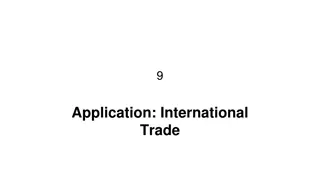
Determinants and Diagonalization of Square Matrices
Dive into the world of determinants and diagonalization of square matrices, learning how to find determinants, diagonalize matrices, and explore triangular matrices. Discover the properties and calculations involved, along with examples to enhance your understanding.
Download Presentation

Please find below an Image/Link to download the presentation.
The content on the website is provided AS IS for your information and personal use only. It may not be sold, licensed, or shared on other websites without obtaining consent from the author. If you encounter any issues during the download, it is possible that the publisher has removed the file from their server.
You are allowed to download the files provided on this website for personal or commercial use, subject to the condition that they are used lawfully. All files are the property of their respective owners.
The content on the website is provided AS IS for your information and personal use only. It may not be sold, licensed, or shared on other websites without obtaining consent from the author.
E N D
Presentation Transcript
Chapter 3 Determinants and Diagonalization
OUR GOAL o How to find the determinant of a square matrix? o How to diagonalize a square matrix?
Determinant of a square matrix Determinant of an nxn matrix A are denoted by det(A) or |A|. For 2 x 2 matrices: det? ? ? Or ? ? ? ? ? = ?? ?? = ?? ??
3 x 3matrices: + - + ? ? ? ? ? ? ? ? ? = det(A) = - b.det? ? ? + c.det? ? +a.det? ? ? ? ? = aei afh (bdi bgf) + cdh cge
Example Find the determinant of the matrix 3 2 2 2 0 1 1 ? = 1 3
The determinant of 3x3 matrix (only) 2 2 1 1 3 col co col a b c a b d e f d e g h i g h + + - - col col l ????det ? , -3 2 2 -2 0 1 3 2 2 2 0 1 1 ? ??? ? = 1 3 - + = + + cdh ceg afh bdi det A aei bfg
Definition a d g b e h c f i e h f i d g f i d g e h ( ) + ( ) ( ) + = = + + d e t . . . . . . A a b c a a a 11 12 13 (1,1) (1 ,2) (1,3) cofactor c ofactor cofactor If A is an mxm matrix then the determinant of A is defined by detA=ai1ci1(A)+ai2ci2(A)+ +aimcim(A) or detA= a1jc1j(A)+a2jc2j(A)+ +amjcmj(A) 1 0 0 0 2 6 7 1 1 5 4 1 0 8 6 4 0 0 = = 17 1 0 8 68 1 2 2
The determinant of triangular matrices Determinant = a11.a22 ann
Examples Find det(A), det(B), det(AB), det(A+B) 2 3 1 2 5 1 2 4 ? = ??? ? = det(A.B) = det(A).det(B) det(A+B) det(A) + det(B)
Examples Find det(A), det(3A), det(A2) if 2 1 3 5 ? = o det(cA) = cndet(A) o det(Ak) = [det(A)]k
Properties For all nxn matrices A, B: o det(A.B) = det(A).det(B) o det(kA) = kndet(A) o det(AT) = det(A) o det(A-1) = 1/det(A) o det(Ak) = [det(A)]k
The determinant of triangular matrices Determinant = a11.a22 ann
Examples o Find the determinants 1 0 0 2 3 0 3 2 |?| = = 1.3. 2 = 6, 2 0 3 2 0 2 3 = 6 // from A, interchange row 1 and row 2 1 0 2 4 3 0 2 0 0 6 2 2 = 12 and // from A, -2.(row 1)
Examples o Find the determinants 1 0 2 2 5 2 1 5 = 5 4 And 1 0 0 2 5 0 2 1 1 = 5 The second matrix is obtained from the first matrix by (2*row1 + row3), they have the same determinants.
Determinants and elementary operators 1. i ch 2 d ng (ho c 2 c t) cho nhau, matrix thu c v matrix ban u c nh th c tr i d u nhau. 2. Nh n m t d ng (ho c c t) v i m t s k matrix thu c c nh th c g p k l n det c a matrix c . //kri 3. N u nh n c v o d ng ri r i c ng v o d ng rj (ho c th c hi n tr n c t) nh th c kh ng thay i. // // ri rj cri + rj
Examples 0 2 3 2 2 2 4 1 9 4 2 2 2 2 4 6 1 1 2 3 1 0 0 0 1 2 2 1 3 9 + r 3 r r r 1 + = 3 6 1 0 0 3 2 2 4 1 9 2 2 0 3 2 2 4 1 9 2 2 = 3 r r 1 2 1 4 = 2 2 1 0 1 0 1 4 8 3 3 3 7 4 9 1 0 0 0 1 2 3 1 0 0 0 1 2 3 1 0 0 0 1 2 3 + + 2 7 r r r r 2 2 = 3 4 1 4 8 1 4 7 24 8 7 4 1 4 1 24 8 1 7 = r r ( ) 2 3 = 2 2 2.7 2 7 1 4 9 9 0 0 0 0 7 4 1 0 0 0 1 2 3 1 4 1 0 8 1 23 + 24 r r ( ) ( ) 3 4 = = 1 .1. 2.7 2.7.1. 23 0 0 1 0 2 6 - - 1 5 4 4 4 3 6 5 Do yourself: Find 1 3 1 2
Next det(A) and existence of A-1 o A is invertible det(A) 0 o A formula for finding A-1
(i,j)-cofactor (i,j)-cofactor of a matrix [aij] is defined by cij = (-1)i+jdet(Aij), where Aij is the matrix obtained from A by deleting row ith and column jth 2 3 1 2 1 0 1 For example, given A = row 2 2 1 column 3 Then, c23 = (-1)2+3det 2 = -1.(-1) = 1 3 2 1 Do yourself. Find all cofactors cij of the matrix A
How to find A-1? An nxn matrix A is invertible if and only if det(A) 0 Furthermore, 1 A-1= det ????(?), where the adjugate matrix adj A is defined as adj(A) = [ i,j cofactors]Transpose
Adjugate matrix The adjugate matrix of A is the matrix ... ... ... ... c c c c c c 11 21 1 n = 12 ... c 2 2 2 n adjA ... c ... c 1 2 n n nn For example, 1 1 2 0 3 0 1 1 2 1 ( ) ( ) 1 1 + 1 2 + = = = = = A 3 1 . We have c 1 3, c 1 3, 11 12 1 1 2 0 1 = = = = = = = = = c 3, c 3, c 6 3 2 1 2 1 5 11 12 13 = c c 2, c 2, c 1, c 1, c 4, adjA 3 6 21 22 23 5 4 31 32 33
Theorem of Adjugate Formula If A is any square matrix, then A(adjA)=(detA)I In particular, ifdetA 0 then A is invertible and 1 = 1 A adjA det A For example, 1 1 2 2 1 3 = = A 0 0 2 0 1 det A 2 and adjA= 0 1 0 1 2 1 0 3/2 2 1 3 1 1/2 10 2 A = = 1 1 1 0 1/2 1/2 0 0 2 0 0 1 Note that [ ]
Diagonal matrices An nxn matrix is called diagonal matrix if all its entries off the main diagonal are zeros 0 ... ... ... ... 0 0 ... 1 0 ... 0 ( ) = = 2 , ,..., D diag 1 2 n ... 0 n For example 3 0 0 0 1 0 0 0 0 0 0 0 2 ( ) 3, 2,1,4 = diag 0 0 4
Diagonalization Diagonalizing a matrix A is to find an invertible matrix P such that P-1AP is a diagonal matrix P-1AP=diag(1, 2, , n) For example, 2 4 1 1 1 o Given a matrix A, A = 1 4 1 o Find a matrix P, P = o Compute P-1AP, 3 0 0 = 1 P AP 2
How to find P? 4 x x + x 2 ( ) x ( ) ( )( ) = + = 2 Find c =det xI A : 2 x 1 4 x x 6 a th c c tr ng A 1 1 (characteristic polynomial) ( ) x = = = c 0 x 3 x 2 C c gi tr ri ng (eigenvalues) c a A + = + A = = x 4 y 0 ( ) x=3: solve the system 3 I A X 0 x 4 y 0 = = N u t 0 th X=(-4t,t) c g i y x t x 4 = = X t l v c t ri ng (eigenvectors) ng v i gi tr ri ng x=3 1 y 4 t + = 4 = x 4 y 0 ( ) = x=-2: solve the system 2 I A X 0 x y 0 = = N u t 0 th X=(t,t) Relationship between eigenvalues and eigenvectors : eigenvalue (a number) X: -eigenvector (remember: vector X 0) ( I-A)X=0 AX= X y t x 1 = = X t c g i l v c t ri ng ng v i x=-2 1 y x t 4 1 1 3 0 0 = 1 Choose P= P AP 1 2 2 0 4 1 4 2 1 4 1 4 1 4 = = = = = 1 P , P , P , P ,...are allowed. In case P= , P AP 1 1 1 2 1 1 1 1 1 1 0 3
Example 1 2 1 2 = Find the eigenvalues ang eigenvectors and then diagonalize the matrix The characteristic polynomial of A is 1 1 ( ) ( 2 2 0,3 are eigenvalues = x A x = = 2) 2 = = = = 1)( ( 3) 0 0 3 c x x x x x x x A x ( ) = 0: Solve the system 0I-A X=0 x 1 1 = P x 1 2 1 0 2 0 1 10 0 0 1 = X t 1 2 0 1 0 0 0 3 ( ) = 3: Solve the system 3I-A X=0 = 1 P AP 2 10 1 0 2 0 10 0 0 1 2 = X t 2
Use the fact: if x1, x2,, xm are eigenvalues of an nxn matrix , then det(A) = x1.x2 xm First, det(A) = 4 We know that det(A) = the product of eigenvalues 4 = 1.2.2 f // x1=1, x2 = x3 = 2.
Use the fact: if X is an eigenvector of a matrix A corresponding an eigenvalue k, then AX = kX
When is A diagonalizable? Theorem A is diagonalizable iff every eigenvalue of multiplicity m yields exactly m basic eigenvectors, that is, iff the general solution of the system ( I-A)X=0 has exactly m parameters. For example, 0 1 = A is not diagonalizable. 1 2 x 1 ( ) x ( ) ( ) ( ) 2 = = = + = + = = = 2 In fact, c det xI A x x 2 1 x 2 x 1 x 1 0 x 1 A 1 x 2 1 0 1 1 1 0 ( ) = = x 1 (multiplicity 2): solve the system 1 I A X 0 1 1 0 0 0 0 1 = X t one parameter not diag onalizable 1
When is A diagonalizable? 0 1 1 0 1 1 is not diagonalizable. = = A 2 0 0 x 1 1 ( ) x ( ) ( ) ( ) 2 = = = + = = = 3 In fact, c det xI A 1 2 x 1 x x 3 x 2 x 1 x 2 0 x 1 x 2 A 0 1 0 1 1 1 1 1 0 ( ) 1 (multiplicity 2): solve the system = = x 1 I A X 0 1 2 1 1 0 1 0 0 0 0 2 0 0 1 0 0 one parameter not diagonalizable
When is A diagonalizable? 0 1 1 0 1 1 is not diagonalizable. = = A 2 0 0 x 1 1 ( ) x ( ) ( ) ( ) 2 = = = + = = = 3 In fact, c det xI A 1 2 x 1 x x 3 x 2 x 1 x 2 0 x 1 x 2 A 0 1 0 1 1 1 1 1 0 ( ) 1 (multiplicity 2): solve the system = = x 1 I A X 0 1 2 1 1 0 1 0 0 0 0 2 0 0 1 0 0 one parameter not diagonalizable
SUMMARY o Determinants of nxn matrices o Properties: o det(AB) = det(A)det(B) o det(cA) = cndet(A) o det(AT) = det(A) o det(A-1) = 1/det(A) o Determinants and elementary operators o Determinants and inverse of a matrix o An nxn matrix has an inverse if and only if det(A) 0 o A-1 = adj(A)/detA o Diagonalization o Characteristic polynomial o Eigenvalues o Eigenvectors






















